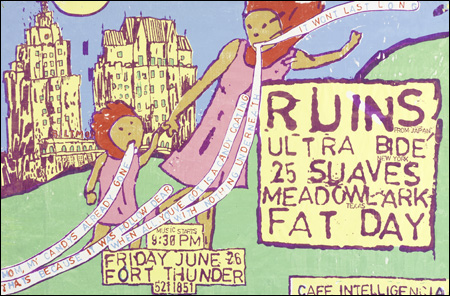
THREE ROOMS: of posters at “Wunderground” give a sense of how exciting and innovative the best Providence design was. |
In 1995, a quartet of Rhode Island School of Design dropouts rented part of a defunct mill in Providence’s rundown Olneyville neighborhood, about a 15-minute bike ride from downtown. They wanted a big place to host rock shows, be loud at all hours, make stuff. Others joined them, up to 14 occupants at a time, and they made silkscreened posters, paintings, paper sculptures, and photocopied comic books, all of which seemed to entail some combination of monsters or caves or weird critters. They hosted speed-metal concerts and insane costumed wrestling matches and Halloween parties with fantastic mazes for guests to decipher. Every surface of the loft became encrusted with posters and toys and bicycle parts and masks and junk. They called it Fort Thunder.

The gang’s art was included in the 2002 Whitney Biennial. Their work was great. And it inspired greatness among the artists of Providence. The Man smashed the old brick building in 2002 to erect a supermarket. Still, Fort Thunder’s ghost lingers over what is sometimes called “the big fun artmaking party that is Providence.”
At least, that’s how the legend goes. Life isn’t quite so neat (some students did graduate, for example), but it’s our local myth and a useful place to begin to understand “Wunderground,” the dazzling and inspiring show at the RISD Museum through January 7. This exhibit offers an eye-popping, floor-to-ceiling survey of practically every poster produced to advertise under-the-radar Providence shenanigans from 1995 to 2005, plus Shangri-la-la-land, a “towering sculptural village” by nine artists that aims to represent the best of the scene now.
When I catch up with Brian Chippendale, he tells me he met Mat Brinkman when they were roommates at RISD. Together they would found the Fort. “When we came here, there was nothing to do, it was really boring. We said, ‘Let’s do whatever we want.’ ”
“Wunderground” offers three rooms of posters, including numerous traditional concert posters that reveal how exciting and innovative the best Providence design was. A 1999 Brinkman poster advertising a concert by Melt Banana and Chippendale’s band Lightning Bolt shows ghostly blobs hopping up and down on a pile of cubes inspired by the Atari game Q*bert. Fort Thunder works frequently have characters wandering through dark uncharted caverns, an echo of the first-person adventure video games, like The Legend of Zelda and Tomb Raider, that the artists played to pass cold winter nights in the poorly heated Fort. They applied what Chippendale calls a clunky, crude “wrong design sense” to heavy-metal, comic-book, and Dungeons & Dragons iconography. They transformed the obsessive mazes of adolescent-boy notebook doodles into art that approaches abstraction but never quite heads over the precipice. Wordplay (“Get wready 2 wrestle”) is everywhere. Their primary media — screenprints, photocopies, burned CDs — reflect a do-it-yourself ethos and a desire to produce art in numbers that would keep it cheap and accessible.
Chippendale’s work features little guys scurrying around and lavish layering that arises naturally out of screenprinting and the endlessly collaged walls of Fort Thunder. (At one point he was tacking up emptied food containers.) During the fight to save the Fort, he made a poster of a heaping tower of buildings and cartoon characters that was supposed to evoke the endangered mill lofts: “Support the mills and the art community within them by coming to the public hearing in city hall . . . this may be our only chance.”
The “Wunderground” organizers don’t identify individual posters by their makers. That’s in line with the anonymity of the Providence style of secret hideouts, code names, and masks, but it frustrates efforts to trace relationships between the posters and the installations next door, or the interactions between artists, which is what these punk communes are all about. As far as I can gather, the Fort style arose not so much from collaboration as from the coincidental coming together of very talented artists with shared interests. Groups inspired by the Fort, like the Hive Archive, a feminist collective founded in 2000, and the Dirt Palace, a feminist collective it spawned in 2002, fed off the scene’s creative energy, but they reflect more diverse tastes. This is apparent in the events they host: music as well as poetry and teach-ins on US–Middle East relations. The Fort could have a slobbery roughhousing Lost Boys vibe; the ladies add a welcome counterpoint.
Erin Rosenthal, a rare female Fort alum, contributes a charming pink poster for a 2002 concert at the Dirt Palace with what looks like a masked donkey scaling a hill, much of the design seemingly assembled from chads made with a hole puncher. The posters of Xander Marro, one of the founders of the Hive, often show women in beehive hairdos and old-time goth motifs.